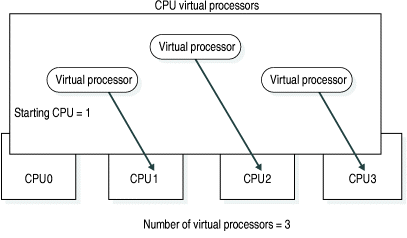
The CPU virtual processor runs all session threads (the threads that process requests from SQL client applications) and some internal threads. Internal threads perform services that are internal to the database server. For example, a thread that listens for connection requests from client applications is an internal thread.
The right number of CPU virtual processors is the number at which they are all kept busy but not so busy that they cannot keep pace with incoming requests. You should not allocate more CPU virtual processors than the number of hardware processors in the computer.
The NUMCPUVPS configuration parameter allows you to specify the number of CPU virtual processors that the database server starts initially. For information about the NUMCPUVPS configuration parameter, refer to the IBM Informix: Administrator's Reference.
To evaluate the performance of the CPU virtual processors while the database server is running, repeat the following command at regular intervals over a set period of time:
onstat -g glo
If the accumulated usercpu and syscpu times, taken together, approach 100 percent of the actual elapsed time for the period of the test, add another CPU virtual processor if you have a CPU available to run it.
For an additional consideration in deciding how many CPU virtual processors you need, refer to Running Poll Threads on CPU or Network Virtual Processors.
If you are running multiple CPU virtual processors on a multiprocessor computer, set the MULTIPROCESSOR parameter in the ONCONFIG file to 1. When you set MULTIPROCESSOR to 1, the database server performs locking in a manner that is appropriate for a multiprocessor computer. For information on setting multiprocessor mode, refer to the chapter on configuration parameters in the IBM Informix: Administrator's Reference.
If you are running only one CPU virtual processor, set the MULTIPROCESSOR configuration parameter to 0 and set the SINGLE_CPU_VP parameter to 1.
Setting MULTIPROCESSOR to 0 enables the database server to bypass the locking that is required for multiple processes on a multiprocessor computer. For information on the MULTIPROCESSOR configuration parameter, refer to the IBM Informix: Administrator's Reference.
Setting SINGLE_CPU_VP to 1 allows the database server to bypass some of the mutex calls that it normally makes when it runs multiple CPU virtual processors. For information on setting the SINGLE_CPU_VP parameter, refer to the IBM Informix: Administrator's Reference.
Setting the SINGLE_CPU_VP parameter to 1 imposes an important restriction on the database server: only one CPU virtual processor is allowed and you cannot add CPU virtual processors while the database server is in online mode.
For more information, see Adding Virtual Processors in Online Mode.
You can add or drop CPU class virtual processors while the database server is online. For instructions on how to do this, see Adding Virtual Processors in Online Mode and Monitoring Virtual Processors.
Some operating systems lower the priority of long-running processes as they accumulate processing time. This feature of the operating system is called priority aging. Priority aging can cause the performance of database server processes to decline over time. In some cases, however, the operating system allows you to disable this feature and keep long-running processes running at a high priority.
To determine if priority aging is available on your computer, check the machine notes distributed with the server.
If your operating system allows you to disable priority aging, you can disable it by setting the NOAGE parameter. For more information on the NOAGE configuration parameter, refer to the IBM Informix: Administrator's Reference.
On some multiprocessor platforms that support processor affinity, you can assign virtual processors to specific CPUs. When you assign a virtual processor to a specific CPU, the virtual processor runs exclusively on that CPU.
You can set the AFF_SPROC and AFF_NPROCS parameters in the ONCONFIG file to implement processor affinity on multiprocessor computers that support it.
Set the AFF_NPROCS parameter to the number of CPUs to which you want to assign CPU virtual processors. Do not set AFF_NPROCS to a number that is less than the number of CPU virtual processors you have allocated. The number of CPUs should not be less than the number of CPU virtual processors that you allocate.
Set the AFF_SPROC parameter to the number of the first CPU to which a CPU virtual processor should be assigned. The database server assigns CPU virtual processors to CPUs in serial fashion, starting with this processor. The first CPU is number 0. For example, if the computer has four CPUs and you set NUMCPUVPS to 3, AFF_SPROC to 1, and AFF_NPROCS to 3, the three CPU virtual processors are assigned to the second, third, and fourth CPUs, respectively.
The value of AFF_NPROCS plus the value of AFF_SPROC must be less than or equal to the number of CPUs. In the previous example, if you set AFF_SPROC to 2, the database server would display an error message because 3 (AFF_NPROCS) plus 2 (AFF_SPROC) equals 5, and only four CPUs are available.
Figure 27 illustrates the concept of processor affinity.

To see if processor affinity is supported on your platform, refer to the machine notes file.
Home | [ Top of Page | Previous Page | Next Page | Contents | Index ]